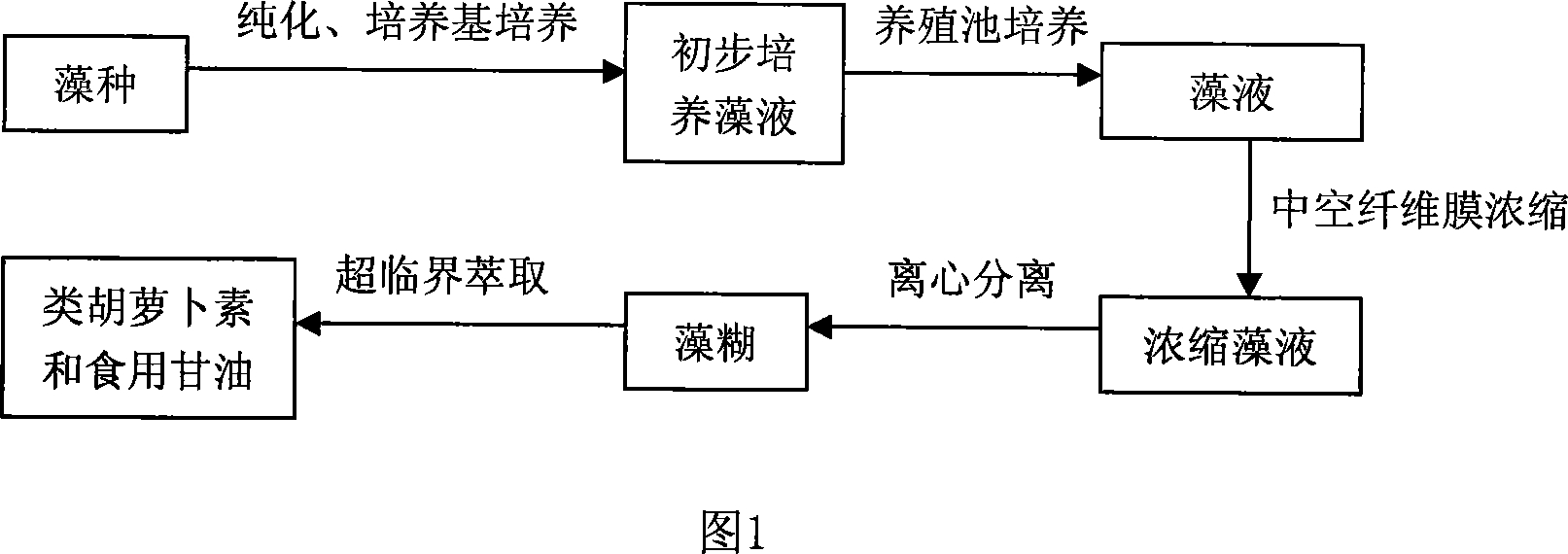Method of extracting carotenoid and edible glycerol from Dunaliella sallina
A technology of carotene and Dunaliella salina, which is applied in the fields of edible oil/fat, application, food science, etc., can solve the problems of affecting the recycling of culture medium, strict quality deviation requirements, and high collection costs, so as to achieve less damage to algae, High economic value, environmentally friendly effect
- Summary
- Abstract
- Description
- Claims
- Application Information
AI Technical Summary
Problems solved by technology
Method used
Image
Examples
Embodiment 1
[0022] Under the following main nutrient concentrations, the concentration of sodium bicarbonate is 10mmol / L, the concentration of sodium nitrate is 1mmol / L, the concentration of sodium dihydrogen phosphate is 0.2mmol / L, and the concentration of sodium chloride is 1.5mol / L, culture for 7 days , the biomass is 1 million / ml, the carotenoid content reaches 10 g / m3, and the practical glycerin content reaches 20 g / m3;
[0023] Hollow fiber membrane modules are used to concentrate the above algae liquid. The hollow fiber membrane interception rate is 30KDa. The process adopts cross-flow circulation mode. The circulation pump is a peristaltic pump. The operating pressure is 0.1 bar, the flow rate of algae liquid on the membrane surface is 10m / s, and the membrane flux is 30L. / m 2 h, backwash at 5-hour intervals to maintain the flux, use pH 4.0 acid washing to remove inorganic particles attached to the membrane surface, and sodium hypochlorite to clean the protein attached to the memb...
Embodiment 2
[0026] Under the following main nutrient concentrations, the concentration of sodium bicarbonate is 15mmol / L, the concentration of sodium nitrate is 2mmol / L, the concentration of sodium dihydrogen phosphate is 0.4mmol / L, and the concentration of sodium chloride is 1.5mol / L. Culture for 10 days , with a biomass of 1.5 million / ml, of which the content of carotenoids reaches 20 g / m3, and the content of practical glycerin reaches 30 g / m3;
[0027] The hollow fiber membrane module is used to concentrate the above algae liquid. The hollow fiber membrane interception rate is 5KDa. The process adopts the cross-flow circulation mode. 10L / m 2 h, 1-hour interval backwashing to maintain flux, 1-day intervals with pH 4.0 acid washing to remove inorganic particles attached to the surface of the membrane, sodium hypochlorite to clean the protein attached to the membrane surface, and the concentration factor is 30 times. Use a centrifuge to further concentrate the algae liquid, remove the su...
Embodiment 3
[0030] Under the following main nutrient salt concentrations, the concentration of sodium bicarbonate is 12mmol / L, the concentration of sodium nitrate is 1.4mmol / L, the concentration of sodium dihydrogen phosphate is 0.25mmol / L, and the concentration of sodium chloride is 1.5mol / L. day, the biomass is 1.2 million / ml, the carotenoid content reaches 15 g / m3, and the practical glycerin content reaches 23 g / m3;
[0031] Hollow fiber membrane modules are used to concentrate the above algae liquid. The interception rate of the hollow fiber membrane is 15KDa. The process adopts the cross-flow circulation mode. The circulation pump is a peristaltic pump, the operating pressure is 0.2bar, the flow rate of the algae liquid on the membrane surface is 10m / s, and the membrane flux is 14L / m 2h, backwash at intervals of 2 hours to maintain the flux, use pH 4.0 acid washing to remove inorganic particles attached to the surface of the membrane, and protein attached to the surface of the membr...
PUM
 Login to View More
Login to View More Abstract
Description
Claims
Application Information
 Login to View More
Login to View More - R&D
- Intellectual Property
- Life Sciences
- Materials
- Tech Scout
- Unparalleled Data Quality
- Higher Quality Content
- 60% Fewer Hallucinations
Browse by: Latest US Patents, China's latest patents, Technical Efficacy Thesaurus, Application Domain, Technology Topic, Popular Technical Reports.
© 2025 PatSnap. All rights reserved.Legal|Privacy policy|Modern Slavery Act Transparency Statement|Sitemap|About US| Contact US: help@patsnap.com

